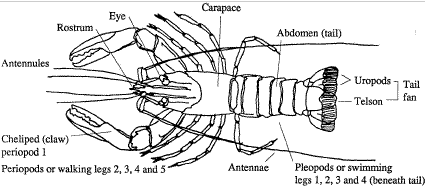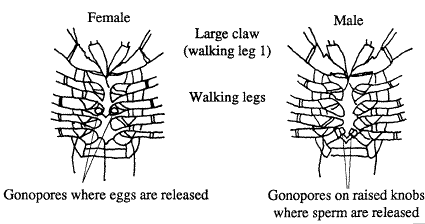One of the more popular pastimes for visitors to Tinaroo Dam is that of catching Redclaw. During your time on Camp you may well have the chance to use our Redclaw pots to trap, study and release some of these creatures.
Where do they come from?
Redclaw crayfish are native to the Gulf of Carpentaria in Northern Australia. They belong to a group of animals known as crustaceans. They have been taken and bred in many parts of Australia including Tinaroo Dam.
Physical characteristics
The body has two main parts the abdomen (tail) and the cephalothorax (head). These are covered by a carapace (shell) to protect the internal organs.

They have poor eyesight and use their antennae and antennules as sense organs, to locate food, test water temperature and salinity. The redclaw and other crayfish are different to prawns or shrimps in that they have larger claws and heavier shells.
Reproduction
The spawning season for redclaw is mainly controlled by temperature; between 25 and 30 degrees Celsius. In natural conditions they normally spawn in late spring and autumn. Each female produces about 300 to 1000 eggs - the larger the female the more eggs. The fertilized eggs become firmly attached to the fine hairs under the tail. It takes 6 to 10 weeks for the eggs to hatch into miniature adults. Within a week the juveniles become independent
Growth
As the redclaw grows it sheds its shell - this is called moulting. The new shell is larger and allows the crayfish to grow. For some hours after moulting the crayfish is very soft. In newly hatched crayfish, moulting may occur every couple of days. Redclaw will live from between 4 and 5 years and grow to about 800g.
Feeding
In nature, the crayfish eat decaying plant and animal material. In aquariums, crayfish will eat a variety of foods.
Respiration
Crayfish breathe by removing oxygen from the water which passes over their gills. Redclaw can live out of water for several days but only under cool moist conditions.
Identifying male and female
The sex of a redclaw is most easily identified by studying its claws. The male claw is relatively large and swollen compared to that of the female. The male also has a soft, bright red membrane on the outside of the claw. In addition, if you hold the crayfish carefully and look underneath the body you can see the difference between male and female. See diagram below:

Habitat
Redclaw will live in any permanent waterway - river, creek, dam or pond. They do not burrow into the banks as some crayfish do. They prefer to live inside some type of Tunnel - in nature this is often a hollow log - in ponds this can be a piece of pipe or an old tyre.
Rules and Regulations
There are strict rules and regulations about catching redclaw - there is a special pamphlet produced by the DPI that details all the rules. In summary they are as follows:
Each person is only allowed to use four traps (pots).
Each pot and float must have the name and address of the person using the trap marked on them.
All females carrying eggs and/or young must be returned to the water.
A bag limit of 40 redclaw applies.